History
Loss
On the 30th or 31st of May, 1698, a Dutch ship was lost near a place called Punta del Holandés in Cuba, between Cape Corrientes and Cape San Antón. It is not clear whether the location was named after this event.
The cargo consisted of sugar, logwood (campeche, used as a dye) and hides. The master and owner of the ship was a certain Wilhelm Sievers from Hamburg. Hendrich Klasen was boatswain and Jan Klinckart - born in Amsterdam - was the pilot. As is often the case in reports from this period, the name of the master is given but not the name of the ship itself.
The cargo was partly salvaged and auctioned. Mentioned especially were a bronze ship's bell, 26 rosaries, cocoa, iron shots, a copper boiler, clothes, 11.416 silver pesos (so-called reales de ocho or pieces of eight) and 334 gold Castilian doblas (coins). The auction of the salvaged goods was held in Havana on August 2nd 1698. A source states that 1894 reales and 14.864 pesos were confiscated - thus it seems that there was more money on board then mentioned earlier.
Archaeology
The wreck site is near the coast at a depth of three metres. On the site 18 guns, 4 anchors and ballast stones were found in situ. In October 2014 a survey was performed on the site.
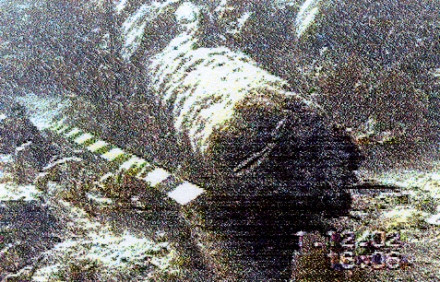
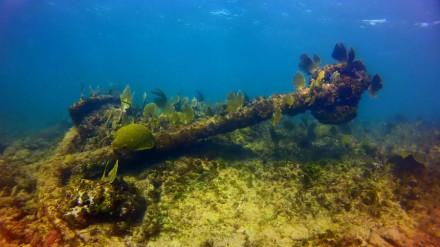
Triangular trade
It is probable that the ship of Wilhelm Sievers was trading in the transatlantic triangular trading system. A normal route in the classic triangular trade would be that a ship from the Dutch West India Company (WIC) and other ships participating in this trade first went from Europe to West Africa with manufactured goods. These were used to procure enslaved Africans in ports along the coast such as Elmina. These enslaved people were then taken to the Americas, often to Curacao in the case of the WIC, where they were often put to work on plantations to produce colonial goods such as sugar and tobacco. The profits from the sale of the enslaved people were then used to buy the same products, which were shipped back to Europe, where they were again sold at a profit. This was more or less the common practice in the triangular trade at the time, which was undertaken by many European nations.
The sources from the Archivo General de Indias in Seville mention that the master Sievers of the Punta del Holandés wreck was questioned concerning his cargo before coming to Cuba. He was specifically asked if he carried enslaved people which he denied. He stated that he carried general cargo. It is unclear if this is true, or that he already sold his possible cargo of enslaved people in Curacao, where the ship docked before going towards Cuba. It is also unclear if he was affiliated with the WIC or that he was a so-called lorrendraaier, a smuggler in the eyes of the WIC.
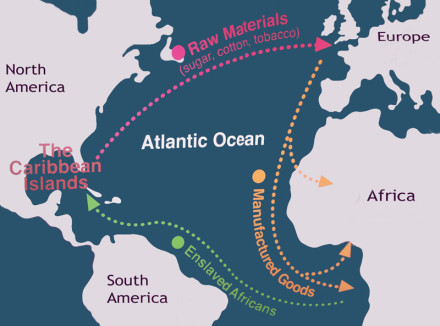
The Sievers family.
The master of the Punta del Holandés wreck was a German from Hamburg. The Sievers family is recorded as an old Hanseatic merchant family from Hamburg. A possible relative of Wilhelm Sievers was Arthur Sievers. He was a notorious pirates in the Indian Ocean area at the same time Wilhelm was trading in the West Indies.
Arthur Sievers is one of the few German pirate known from early modern history. He was born in 1660 near or in Hamburg and died around 1700 in India. It is very probable that they were related.
Description
Date of sinking not totally clear, 30 or 31 May 1668.
Armament: 20 - 25 canons.
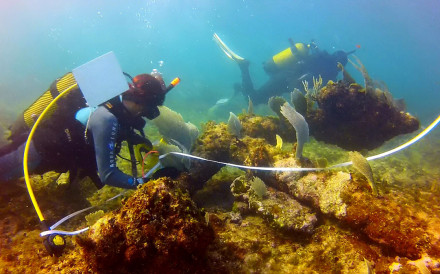
| Master | Wilhelm Sievers |
|---|---|
| People on board | 37 |
| Length | 96 ¼ feet (29.3 m) |
Status
The wooden parts of the ship are not preserved. The site is indicated by 4 anchors and 18 canons.
It was first discovered in 1967 by the 'Department of Underwater Investigations' of the Instituto Oceanologia de la Academia de Ciencias de Cuba.
Research has been performed by SERMAR on the wreck in October 2014.
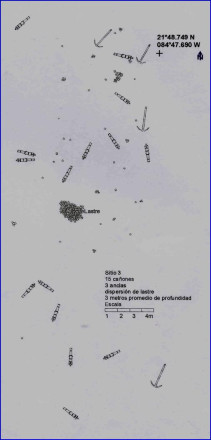
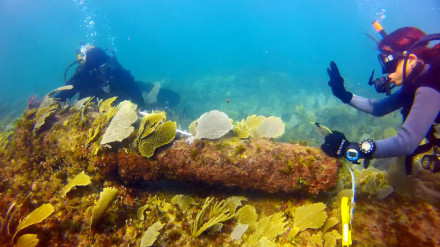
The exhibit 'Presencia holandesa en las aguas Cubanas'.
This exhibit ran from 16 November 2014 until 1 March 2015 in the Museo Castillo de la real Fuerza in Havana. It presented the results of an historical and archaeological research project on two Dutch wrecks in Cuban waters, one of which was the the Punta del Holandés wreck. The findings were presented in 13 panels describing the Dutch influence in Cuban waters.
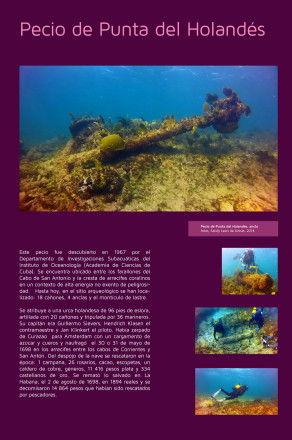

References
- Brouwers, W. (2015).
Van vloten, zilver en zeehelden.
Vitruvius 32, juli 2015. - López; A., M. Pavia eI. Diaz: Cronologia de los naufrágios. Colección Raíces. Boloña, La Habana, 2011.
- Archivo General de Indias. Escribanía de Cámara, legajo 53-B.
- Archivo General de Indias. Santo Domingo,legajo 114, Ramo 4 folios 1 y 2 y legajo 143, folios 96 - 292y 355.
- Archivo Histórico Ciudad de La Habana. RealesCédulas y Despachos, Tomo 1693 1723, folios 172, 190 y stes.
- Archivo Nacional de Cuba, Protocolos,Escribanía de Salinas, Tomo 1699 1700.